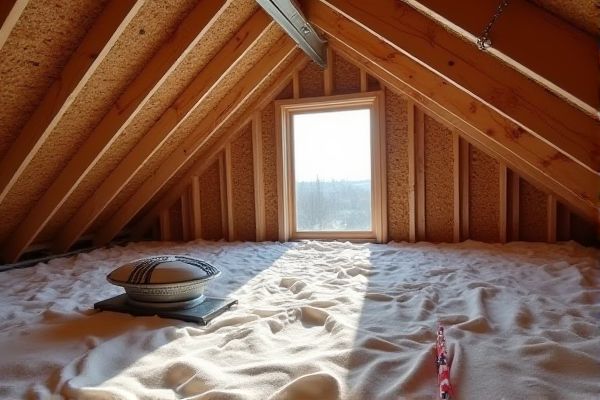
Choosing between a ridge vent and a turbine vent for your attic depends on factors like airflow efficiency, roof type, and weather conditions, with ridge vents offering continuous ventilation along the roof's peak and turbine vents providing powered airflow through wind-driven rotation. Explore the rest of the article to discover which attic ventilation system best suits your home's needs.
Table of Comparison
| Feature | Ridge Vent | Turbine Vent |
|---|---|---|
| Location | Roof ridge | Roof slope or peak |
| Ventilation Type | Continuous airflow along ridge | Rotary ventilation using wind power |
| Operation | Passive, based on natural convection | Wind-driven spinning turbine |
| Airflow Efficiency | Consistent and uniform air exhaust | Variable; depends on wind speed |
| Weather Resistance | Good, integrated with roof shingles | Risk of leaks if not properly installed |
| Maintenance | Low maintenance | Periodic checks needed for turbine function |
| Noise Level | Silent operation | May produce noise when spinning |
| Installation Cost | Moderate | Moderate to high |
| Best For | Effective for all roof types with ridges | Works well in windy areas, any roof |
| Durability | Long-lasting with minimal wear | Moving parts susceptible to wear |
Introduction to Attic Ventilation
Proper attic ventilation is crucial for maintaining your home's energy efficiency and preventing moisture buildup. Ridge vents provide continuous airflow along the roof peak, promoting consistent temperature regulation, while turbine vents use wind power to actively exhaust hot, stale air. Choosing the right system improves attic air circulation, reduces cooling costs, and extends roof lifespan.
What is a Ridge Vent?
A ridge vent is a type of attic ventilation installed along the peak of a sloped roof, allowing hot, moist air to escape from the attic space. Designed to work with soffit vents, ridge vents promote continuous airflow, reducing heat buildup and preventing moisture-related damage. Your home's energy efficiency and roof longevity benefit significantly from the balanced ventilation ridge vents provide.
What is a Turbine Vent?
A turbine vent is a roof-mounted ventilation device that uses wind power to rotate its turbine, creating a vacuum effect to pull hot, moist air out of the attic. This passive ventilation method enhances airflow without electricity, making it energy-efficient and effective in reducing heat buildup and moisture accumulation. Turbine vents are typically installed near the ridge of the roof but can operate effectively in various wind conditions.
How Ridge Vents Work
Ridge vents work by allowing warm, moist air to escape from the attic through a continuous vent installed along the roof's peak, promoting efficient airflow and preventing heat buildup. These vents rely on natural convection, drawing cooler air in through soffit vents to replace the hot air exiting at the ridge. Your attic's temperature regulation improves with ridge vents, reducing energy costs and extending roof lifespan.
How Turbine Vents Work
Turbine vents operate using wind and thermal convection to pull hot, moist air from the attic, spinning a turbine that creates suction and promotes continuous airflow. This ventilation method reduces attic heat buildup and moisture accumulation, improving energy efficiency and preventing mold growth. Compared to ridge vents, turbine vents rely more on external wind conditions to maintain optimal attic ventilation.
Pros and Cons of Ridge Vents
Ridge vents provide continuous ventilation along the roof peak, promoting effective airflow and reducing moisture buildup in your attic, which helps prevent mold and extends roof life. They are visually discreet, blend seamlessly with most roofing materials, and require less maintenance compared to turbine vents. However, ridge vents may be less effective in low-slope roofs or areas with minimal wind, and proper installation is critical to prevent leaks and ensure optimal performance.
Pros and Cons of Turbine Vents
Turbine vents offer effective attic ventilation by utilizing wind power to exhaust hot, moist air, reducing cooling costs and preventing mold growth. However, turbine vents rely on wind to operate efficiently, making them less effective on calm days, and their moving parts require regular maintenance to avoid rust and mechanical failure. Choosing turbine vents for your attic balances energy savings and maintenance needs against variable performance depending on local weather conditions.
Ridge Vent vs Turbine Vent: Key Differences
Ridge vents run continuously along the peak of your roof, providing consistent airflow by allowing hot air to escape evenly, while turbine vents rely on wind to spin and create ventilation, which can be less reliable during calm weather. Ridge vents typically offer better, more uniform attic ventilation and are less prone to leaks compared to turbine vents, which have moving parts and may require more maintenance. Choosing between the two depends on your home's climate and ventilation needs, with ridge vents often preferred for their efficiency and durability.
Choosing the Right Vent for Your Attic
Choosing the right vent for your attic depends on factors like roof design, airflow needs, and climate. Ridge vents provide continuous ventilation along the roof peak, promoting consistent airflow and reducing moisture buildup, while turbine vents rely on wind to spin and exhaust hot air but may be less effective in low-wind conditions. Your attic ventilation efficiency improves by selecting a vent type that matches your specific environment and ensures proper temperature regulation and moisture control.
Final Recommendation: Ridge Vent or Turbine Vent?
Ridge vents provide continuous ventilation along the roof peak, promoting even airflow and reducing moisture buildup in your attic, which enhances energy efficiency and extends roof lifespan. Turbine vents rely on wind to spin and pull air out, offering effective ventilation in windy conditions but may underperform on calm days. For consistent, low-maintenance attic ventilation, a ridge vent generally stands as the superior choice in most climates.
 homyna.com
homyna.com